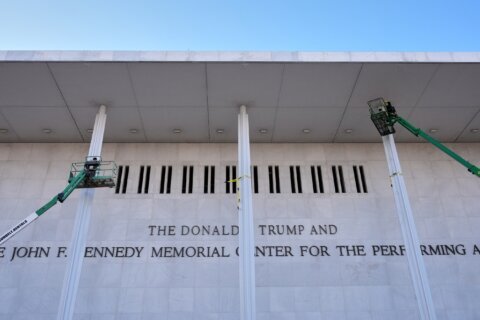WASHINGTON — It’s (Sep)time to say goodbye.
Washington Ballet Artistic Director Septime Webre delivers his final Kennedy Center production this week before handing his beloved company to ballet legends Julie Kent and Victor Barbee in July.
“After 17 years, I am hanging up the point shoes,” Webre told WTOP.
Fittingly, he bows out by saying goodbye to David Bowie and Freddie Mercury with the rock ballet “Bowie & Queen,” which runs now through May 15 at the Kennedy Center.
“I’m glad to be going out with ‘Bowie & Queen’ because it, in lots of ways, is emblematic of the qualities of my tenure: just classical ballet … but also a fun, spirited, cheeky approach,” Webre said.
“If you were intimidated by ballet and didn’t see yourself as a ballet-goer, this is the time to go, because you’re definitely a Bowie and Queen listener. I think you’ll surprise yourself.”
The extravagant evening is divided into two parts — a 30-minute ballet set to Bowie’s music, followed by a 20-minute intermission, before closing out with a 50-minute ballet set to the music of Queen.
“The two pieces contrast beautifully because the David Bowie work is a bit more introspective, and the Queen ballet is this rollicking, full-on, go-for-the-jugular experience,” Webre said.”
“They’re both vocal artists who come with a sense of rebellion. … Freddie Mercury could not have happened without David Bowie before him. Freddie Mercury had, I think, more of a mainstream rock aesthetic in a certain kind of way, but there was a kind of glam rock that united them.”
The Bowie segment is titled “Dancing in the Street” and choreographed by Edwaard Liang, who highlights the quieter part of Bowie’s career. We hear B-Side tracks like “I’m Not Losing Sleep,” which Webre calls “beautiful work for solo,” and “Goodbye Girl,” which Webre calls “a dance for three men in pursuit of two hot ladies,” before culminating with the Mick Jagger duet “Dancing In the Street.”
“They’re actually kind of B-sides, really interesting beautiful songs that I hadn’t known well before,” Webre said. “‘B-sides’ sounds like a bad word; these are really amazing tracks.”
In between the Bowie songs, there’s original music composed by Gabriel Gaffney Smith, as well as violin by S&R Foundation Artist-in-Residence Machiko Ozawa.
“The music in alternation serves as a prologue to those pieces,” Webre said. “[Smith] went back and listened to interviews with Bowie spanning over 20 or 30 years. … [It’s] this beautiful journey. Ultimately, it’s about the joy of dancing and just being yourself and not conforming.”
After intermission, Webre presents the second part of the show, titled “Mercury Half-Life,” referring to Queen frontman Freddie Mercury. It features a string of Queen hits, including “We Will Rock You,” “Bohemian Rhapsody,” “Crazy Little Thing Called Love,” “Fat Bottomed Girls” and “Bicycle Race.”
“The music is so much a part of our collective American psyche,” he said. “But it doesn’t feel like a greatest hits ballet. It doesn’t feel like something you bought from a 1-800 number … because it gels together in an emotional sense. … It’s really heartfelt, like this cathartic, emotional roller coaster.”
Part of that roller coaster is a unique flurry of tapdancing set to rock music.
“Tapping we identify with Fred Astaire, something suave, or Savion Glover. [This] is so raw with the Queen music. For example, there’s tapping in ‘Bohemian Rhapsody.’ … Imagine the rhythms of a drummer doing a wild rock solo — imagine making that syncopated sound with your tap shoes.”
The entire thing is choreographed by Trey McIntyre.
“He’s the bad boy of the ballet world,” Webre said. “Trey has made a lot of ballets for The Washington Ballet. In fact, I commissioned my first work from him when I first arrived here 17 years ago.”
Yes, it’s been a wild 17 years for Webre at The Washington Ballet, a run that has included other rock ballets celebrating the music of The Beatles, Rolling Stones and Beck. It’s all part of Webre’s continued effort to reach new audiences who haven’t been exposed to the beauty of ballet.
“I think audiences need a hook into the world of ballet sometimes. We have this great language with a reputation for just being dead swans floating in a lake,” Webre joked.
Enter the perfect “swan song” — “Bowie & Queen.”
“Ballet is thought of as an establishment art form. We are what rock was essentially rebelling against,” Webre said. “Rock artists were tearing down [this notion], so having a combination of those two just makes for an interesting dynamic. It loosens ballet up and turns it on its head, but it remains ballet.”
That’s the legacy of Webre’s career, an outside-the-box approach that both captures the attention of ballet newcomers and commands the technical respect of die-hard ballerinas.
“[My goal has been to] present really good ballet, dancers dancing in a really passionate way, and surprising audiences,” Webre said. “It’s definitely not your grandmother’s ballet.”
He still has two more smaller shows on tap — “Coppélia” at The Arc in Anacostia and “The Little Mermaid” at Imagination Stage in Bethesda — but “Bowie & Queen” is his final on the main stage.
“I’ve had an amazing time and I feel so proud,” Webre said. “If I’m going to be replaced, I want to be replaced by someone like Julie Kent and Victor Barbee, so I know the ballet will be in good hands. … I’m looking forward to creating work with dancers and not being a boss for a little while.”
Webre views this as a pivotal midpoint to his creative expression.
“I’ve been here for 17 years and I will retire as an artist in 17 years (from now). I know in 17 years is when I’m going to say, all right, done, I’m not making any more ballets,” he said.
Next, he’ll choreograph ballets around the world from Australia to Hawaii to Cape Town to Istanbul.
“I’m really going to be staging works that I made at The Washington Ballet and creating world premieres,” Webre said.
Among all the great moments, there have been a few challenges.
Or, to steal a Queen phrase, no bed of roses, no pleasure cruise.
Looking back, he says he only has two regrets.
“One was we had a labor dispute about 10 years ago, and that was really tough,” Webre said. “Our company is so much healthier [now] because we are a union company and we just have a great relationship now and we have all of the job security that just wasn’t in place when I first got here.”
The other regret?
“We have not always been able to perform to live music,” Webre said. “I know we’ve been working toward full orchestra all the time, I know that’s a big goal for Julie.”
Overall, though, it’s been 17 years of fond memories for Webre. He’s particularly enjoyed staging “The Nutcracker” since 2004 — which has become an annual D.C. tradition — as well as other premieres like “The Great Gatsby,” “Alice in Wonderland,” “Carmina Burana” and “Peter Pan.”
But something else is atop his list, something under the radar, but speaking volumes to his character.
“Number One is founding Washington Ballet at The Arc and Dance DC. All of the work that we’ve done in these communities, not just in Anacostia, but in Dance DCs all over the city. 10,000 kids have been through that program. It’s amazing. We have a whole class of girls on pointe in Anacostia where there was no one training in ballet 10 years ago. It’s amazing. That’s a real highlight.”
Click on the Kennedy Center calendar for more information. Listen to the full interview with Septime Webre below:







